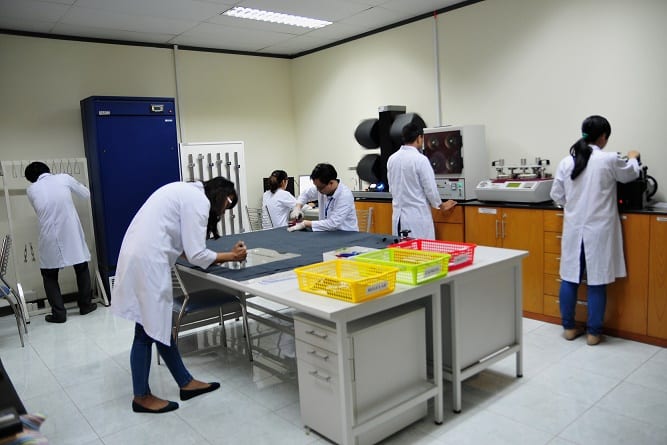Mission of any apparel business is to attain customer satisfaction by ensuring the highest quality. Inability to keep up a sufficient quality standard can consequently be ineffective. In any case, keeping up a satisfactory standard of quality costs exertion. Garment brands face day by day examination for their manufacturers’ working conditions, their natural effect and their lead times. Your items finally need to represent themselves. Also, there’s no better method to speak to your image than with an item that lives up to your clients’ desires. In any case, you can’t do that without a powerful clothing quality control technique.

In-line inspectors are checking the garment quality
In the garment production industry quality control is drilled appropriate from the underlying phase of sourcing raw materials to the phase of last completed piece of clothing. For fabric and clothing industry item, quality is determined as far as quality and standard of filaments, yarns, fabric specification, color fastness, surface plans and the last completed piece of garments.
Controlling cloth quality begins with setting the correct quality desires and after that investigating and testing your items before they dispatch. So how about we take a gander at four (4) explicit ways you can successfully oversee garment quality—even from a separation.
1. Hire experienced quality controller:
Contract representatives who have industry skill and quality-administration experience. Your whole workforce may not comprise of prepared garment industry representatives; be that as it may, a solid possibility of experienced specialists ought to establish a noteworthy bit of your workforce when you’re centered around improving or supporting the quality of your items.
2. Give correct tolerance for garment measurements:
Estimating garment measurements is a basic part of clothing quality control. Most buyers care about the fit and flexibility of a garment more than some other factors. In any case, cloth measurements can likewise be perhaps the hardest part of apparel quality to make do with your manufacturer.
Garment sewing is a work base procedure, which clothing quality control doesn’t fit cutout consistency between pieces. Not at all like infusion-formed items and others that can be made with institutionalized generation techniques and gear, garments are commonly exclusively hand sewn.
Therefore, you’re bound to discover defects between garments than with different items.
When making article of clothing specs, set a tolerance for each purpose of estimation that considers a little margin of discrepancies. Furthermore, give this rundown of resistances to both your manufacturer and your QC team to guarantee merchandise are created and reviewed to your necessities.
3. Advise for in-house tests during pre-shipment inspection:
In-house testing during final inspection guarantees you’ll get a completed item that lives up to your quality desires, beside fit. Your quality controller can help check your piece of clothing’s durability and functionality with in-house tests that copy standard purchaser use.

An accredited third party garment inspection room
Here are some examples of common in-house tests conducted during garments final inspection in factory.
Dry and wet crocking test
This test involves rubbing a piece of white fabric on color fabric of the clothes for 10 times. Then quality controller or inspector will find the white piece of fabric for any color transfer. This dry crock testing always uses a dry piece of white fabric, whereas the wet crock test uses a wet piece dripping in water.
Seam Strength test
The quality controller stretches a piece of clothes along its stitch line and any part like armholes, necklines etc with a normal tension during the test. This test is ordinarily directed on the full example size assessed, since a quality issue with seams could majorly affect the item’s marketability.
Fitting test
One person of inspection team will put the garment on a model to find if it fits properly. Usually inspection check one per for each size.
Stitches per inch(SPI) test
This is the test of number of stitches per inch in garments. SPI can influence the strength and functionality of cloth seam. Greater number of stitches per inch will increase the strength of seam.
Also, there are some more in-house test to be conducted which are fatigue test for fastener, stretch test etc.
4. Conduct third party laboratory testing for garment quality control
Once in a while you may need to go a stage more distant to oversee clothing quality control. Any issues with generally speaking fabric quality, for example, might be an indication of a fundamental issue with fabric composition.
Garment lab testing ordinarily includes pulling an example of the production material and sending it to an accredited lab for evaluation. Outsider labs can enable you to test samples of dyes, fashion stones, glitters or the base fabric of an article of clothing itself.
Numerous manufacturers will profess to have a certified lab set ready for testing fabric or garments at the factory. Also, some of manufacturers really have an expert and skilled laboratory. In any case, numerous others have, best case scenario, a basic lab for item testing.
Numerous in-house tests for pieces of clothing are easy to direct and monitors probably won’t require any unique training or experiences to perform them. There are many accredited testing laboratories available in Bangladesh. Some of their names are SGS, Intertek, TÜV SÜD, AQF etc.
In Conclusion, garment inspection should, at least, incorporate a progression of fundamental on in-house tests to confirm properties like seam strength, sewing and fit. Think about how to take piece of clothing measurements and whether you have to utilize a third party lab to test your item. At that point make a spec sheet for garments that will enable your factories to comprehend and satisfy your guidelines.
Clothing quality issues can originate from any number of variables. Yet, following these four stages to oversee garment quality can help guarantee your finished products meet your garment specification.